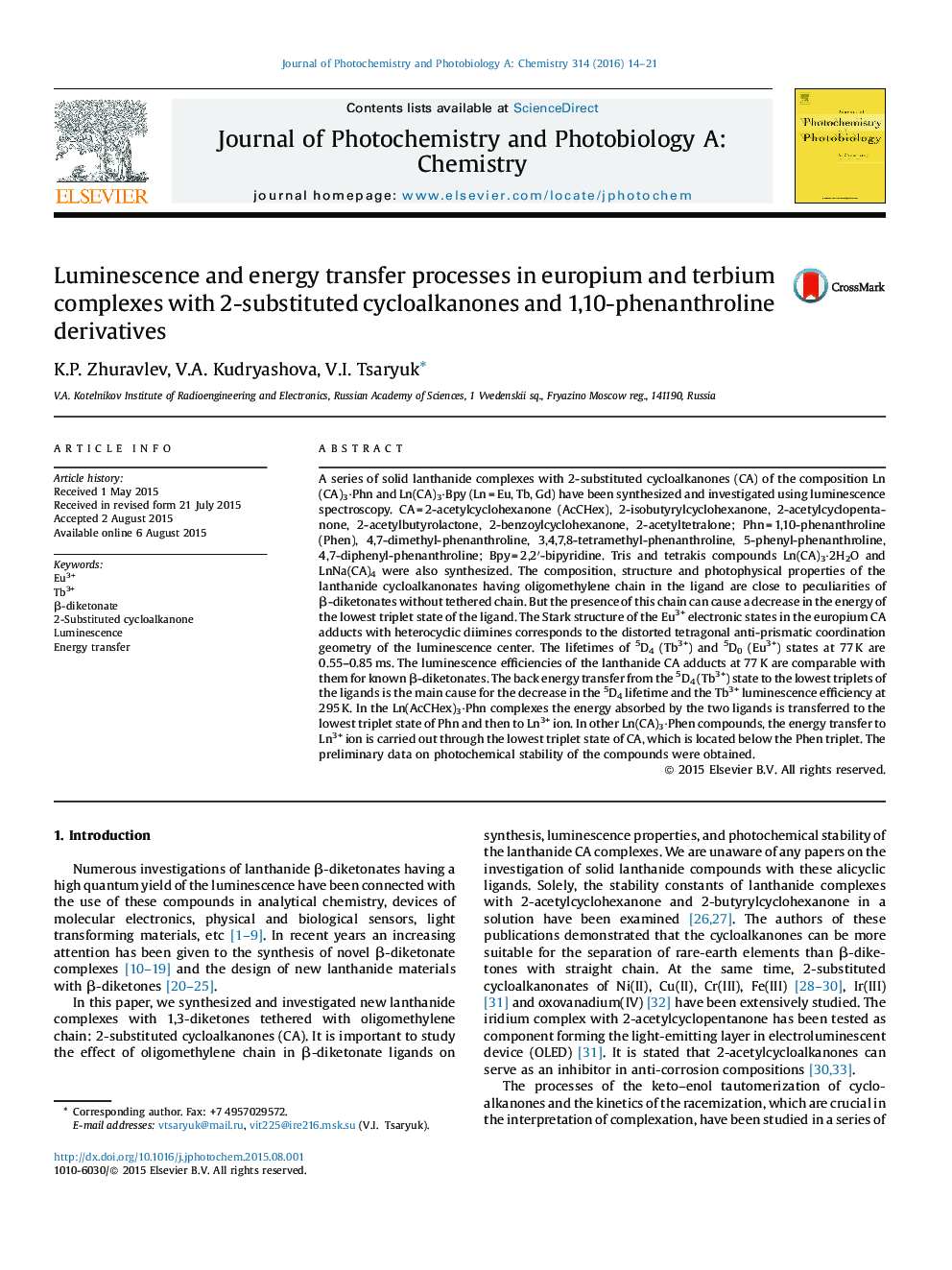| کد مقاله | کد نشریه | سال انتشار | مقاله انگلیسی | نسخه تمام متن |
|---|---|---|---|---|
| 26360 | 43949 | 2016 | 8 صفحه PDF | دانلود رایگان |
• Syntheses of solid Ln3+ compounds with tethered 1,3-diketones.
• Structural identity of Ln3+ β-diketonates with and without oligomethylene chain.
• The time-resolved emission spectroscopic study of Gd3+ compounds.
• Decreasing the Tb3+ luminescence efficiency due to the back energy transfer.
• Preliminary data on photochemical stability of Ln3+ cycloalkanonates.
A series of solid lanthanide complexes with 2-substituted cycloalkanones (CA) of the composition Ln(CA)3·Phn and Ln(CA)3·Bpy (Ln = Eu, Tb, Gd) have been synthesized and investigated using luminescence spectroscopy. CA = 2-acetylcyclohexanone (AcCHex), 2-isobutyrylcyclohexanone, 2-acetylcyclopentanone, 2-acetylbutyrolactone, 2-benzoylcyclohexanone, 2-acetyltetralone; Phn = 1,10-phenanthroline (Phen), 4,7-dimethyl-phenanthroline, 3,4,7,8-tetramethyl-phenanthroline, 5-phenyl-phenanthroline, 4,7-diphenyl-phenanthroline; Bpy = 2,2′-bipyridine. Tris and tetrakis compounds Ln(CA)3·2H2O and LnNa(CA)4 were also synthesized. The composition, structure and photophysical properties of the lanthanide cycloalkanonates having oligomethylene chain in the ligand are close to peculiarities of β-diketonates without tethered chain. But the presence of this chain can cause a decrease in the energy of the lowest triplet state of the ligand. The Stark structure of the Eu3+ electronic states in the europium CA adducts with heterocyclic diimines corresponds to the distorted tetragonal anti-prismatic coordination geometry of the luminescence center. The lifetimes of 5D4 (Tb3+) and 5D0 (Eu3+) states at 77 K are 0.55–0.85 ms. The luminescence efficiencies of the lanthanide CA adducts at 77 K are comparable with them for known β-diketonates. The back energy transfer from the 5D4 (Tb3+) state to the lowest triplets of the ligands is the main cause for the decrease in the 5D4 lifetime and the Tb3+ luminescence efficiency at 295 K. In the Ln(AcCHex)3·Phn complexes the energy absorbed by the two ligands is transferred to the lowest triplet state of Phn and then to Ln3+ ion. In other Ln(CA)3·Phen compounds, the energy transfer to Ln3+ ion is carried out through the lowest triplet state of CA, which is located below the Phen triplet. The preliminary data on photochemical stability of the compounds were obtained.
Figure optionsDownload as PowerPoint slide
Journal: Journal of Photochemistry and Photobiology A: Chemistry - Volume 314, 1 January 2016, Pages 14–21
